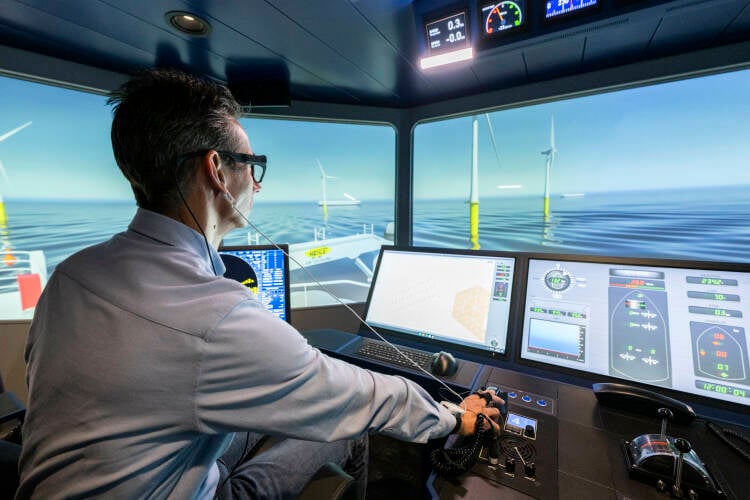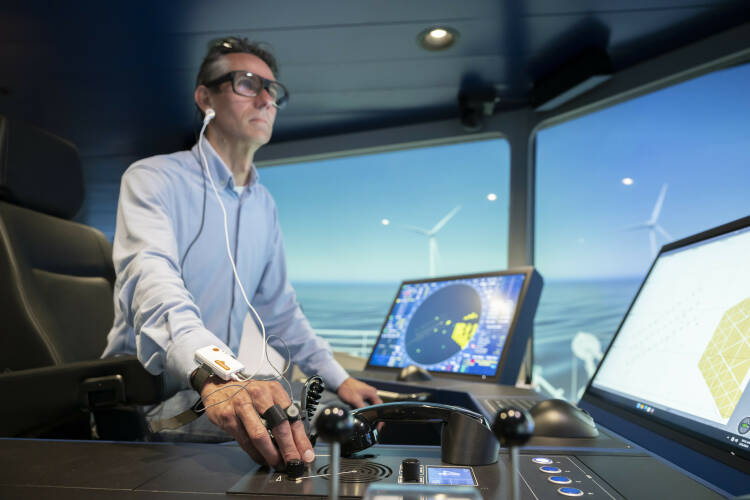June 2024, no. 140









Create a MARIN account to stay updated





Report
Improving safety, efficiency and performance by empowering the human operator
With the rise of new technologies in maritime operations and the growing trend towards technological innovations, a better understanding of the human element is increasingly crucial.
With the current challenges we need to adopt a human centred design approach when developing new tools or procedures. By gaining insight into how people work and how they interact with procedures, tools and technology, we are more able to adapt these to human needs. By making sure that the operator can seamlessly interact with these challenges you enhance operational efficiency and reliability.
Human Factor Team
Within the Human Factor Team at MARIN we try to understand the environment where the operators work in, so we can provide tailormade solutions for existing and future challenges. Our process involves direct collaboration with the operators. We focus on the end-user, the maritime professional: the captain of a containership, a pilot or an inland waterway skipper.
Simulation, Human Observation & Debriefing platform
With these human factor sensors, we are able to gain data which we can use to determine situational awareness by analysing the visual focus (viewing behaviour) of an operator for example. Eye-tracking technology shows where a person is looking, indicating their focus and attention. This is useful to determine how operators prioritise information. This data can guide the design of user interfaces, ensuring critical information is easily accessible and reducing cognitive overload.
In addition, with heart rate measurements, such as heart rate variability, we can gain an understanding about cognitive workload during simulator runs. GSR measures the skin’s electrical conductance, which increases with stress. By monitoring GSR during simulations or operations, trainers can identify high-stress scenarios, helping to develop strategies to manage stress and improve performance. This integration of these human factor measuring tools enables us to assess whether new onboard technology improves performance or imposes additional strain on the crew.
By combining simulator data with human factor measurements, we can improve training and create more effective designs. SHOD offers a more holistic view and goes beyond traditional metrics. The SOSc and SHOD ultimately empowers the human operator and in turn, improves safety, efficiency and performance.
A critical aspect of our work is evaluating effectiveness as a crucial part of the human centred design approach. This allows us to measure the impact of our solutions and makes sure they deliver the intended benefits. To achieve this, we use simulators to create real-life maritime scenarios and apply physiological measurement systems to monitor human responses and performance.
A focus on people in the SOSc
We are excited with our new Seven Oceans Simulator centre (SOSc), where the human element is getting centre stage. The simulation centre puts the human operator in the middle of real-world operational scenarios. Central to the SOSc is our innovative platform called Simulation, Human Observation & Debriefing (SHOD). SHOD enables us to visualise and analyse the complex interactions between the human operator and their operational environment. By seamlessly integrating data from simulators with human physiological measurements - such as eye-tracking, heart rate and galvanic skin response (GSR) – SHOD offers a comprehensive view of how operators respond to various conditions and challenges on vessels.
We are seeing significant shifts in the way we use the sea, particularly with regard to sustainability goals and autonomous vessels. These shifts impact onboard operations, placing new demands on the human operator, who must adapt and interact with evolving systems. When we intervene in these processes, it is vital to grasp the current operational dynamics and prioritise the human operator's role.
The rapid changes in the maritime sector highlight the need for a deeper understanding of the human element within these complex environments. It’s no longer just about the technology; success hinges on centring the human operator in the process.
We are excited with our new Seven Oceans Simulator centre, where the human element is getting centre stage. The simulation centre puts the human operator in the middle of real-world operational scenarios.

Interested? Contact us to discuss your options


More info
SHOD: integrating data from simulators with human physiological measurements.
Human physiological measurements at the Full Mission Bridge to visualise and analyse the complex interactions between human operator and operational environment.
www.marin.nl/sosc




Interested? Contact us to discuss your options
More info
We are excited with our new Seven Oceans Simulator centre, where the human element is getting centre stage. The simulation centre puts the human operator in the middle of real-world operational scenarios.


www.marin.nl/sosc


SHOD: integrating data from simulators with human physiological measurements.
Human physiological measurements at the Full Mission Bridge to visualise and analyse the complex interactions between human operator and operational environment.
June 2024, no. 140
A critical aspect of our work is evaluating effectiveness as a crucial part of the human centred design approach. This allows us to measure the impact of our solutions and makes sure they deliver the intended benefits. To achieve this, we use simulators to create real-life maritime scenarios and apply physiological measurement systems to monitor human responses and performance.
A focus on people in the SOSc
We are excited with our new Seven Oceans Simulator centre (SOSc), where the human element is getting centre stage. The simulation centre puts the human operator in the middle of real-world operational scenarios. Central to the SOSc is our innovative platform called Simulation, Human Observation & Debriefing (SHOD). SHOD enables us to visualise and analyse the complex interactions between the human operator and their operational environment. By seamlessly integrating data from simulators with human physiological measurements - such as eye-tracking, heart rate and galvanic skin response (GSR) – SHOD offers a comprehensive view of how operators respond to various conditions and challenges on vessels.
Simulation, Human Observation & Debriefing platform
With these human factor sensors, we are able to gain data which we can use to determine situational awareness by analysing the visual focus (viewing behaviour) of an operator for example. Eye-tracking technology shows where a person is looking, indicating their focus and attention. This is useful to determine how operators prioritise information. This data can guide the design of user interfaces, ensuring critical information is easily accessible and reducing cognitive overload.
In addition, with heart rate measurements, such as heart rate variability, we can gain an understanding about cognitive workload during simulator runs. GSR measures the skin’s electrical conductance, which increases with stress. By monitoring GSR during simulations or operations, trainers can identify high-stress scenarios, helping to develop strategies to manage stress and improve performance. This integration of these human factor measuring tools enables us to assess whether new onboard technology improves performance or imposes additional strain on the crew.
By combining simulator data with human factor measurements, we can improve training and create more effective designs. SHOD offers a more holistic view and goes beyond traditional metrics. The SOSc and SHOD ultimately empowers the human operator and in turn, improves safety, efficiency and performance.
With the current challenges we need to adopt a human centred design approach when developing new tools or procedures. By gaining insight into how people work and how they interact with procedures, tools and technology, we are more able to adapt these to human needs. By making sure that the operator can seamlessly interact with these challenges you enhance operational efficiency and reliability.
Human Factor Team
Within the Human Factor Team at MARIN we try to understand the environment where the operators work in, so we can provide tailormade solutions for existing and future challenges. Our process involves direct collaboration with the operators. We focus on the end-user, the maritime professional: the captain of a containership, a pilot or an inland waterway skipper.
We are seeing significant shifts in the way we use the sea, particularly with regard to sustainability goals and autonomous vessels. These shifts impact onboard operations, placing new demands on the human operator, who must adapt and interact with evolving systems. When we intervene in these processes, it is vital to grasp the current operational dynamics and prioritise the human operator's role.
The rapid changes in the maritime sector highlight the need for a deeper understanding of the human element within these complex environments. It’s no longer just about the technology; success hinges on centring the human operator in the process.




Improving safety, efficiency and performance by empowering the human operator
Create a MARIN account to stay updated

With the rise of new technologies in maritime operations and the growing trend towards technological innovations, a better understanding of the human element is increasingly crucial.
Report









